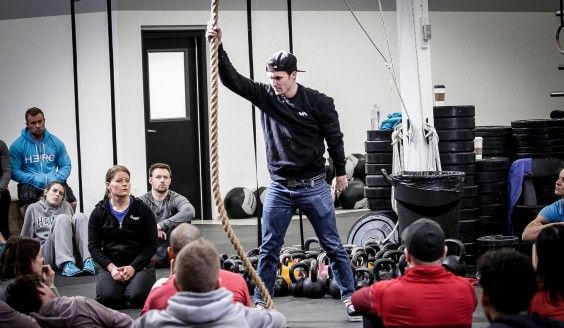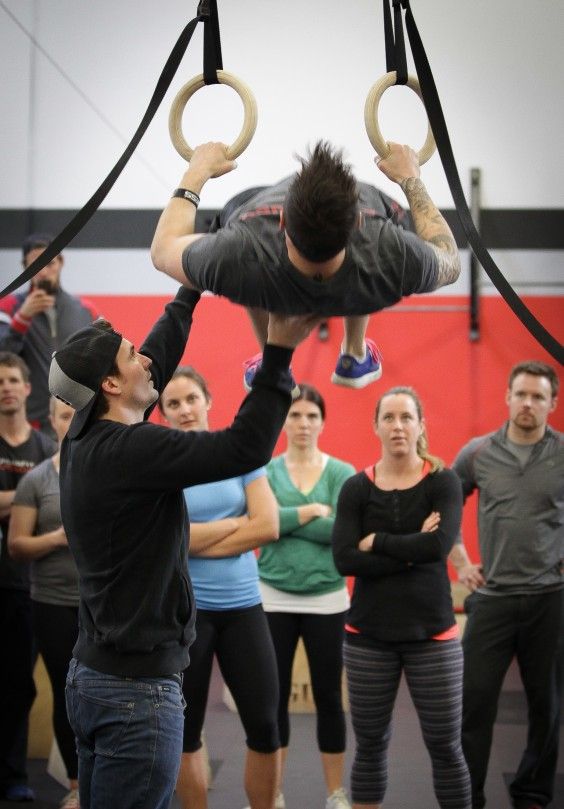Photo by Caragh Camera
For movement specialist Carl Paoli, fitness has a lot to teach us about the fundamental way humans move. No matter if it’s lifting heavy weights or simply figuring out a more efficient way to walk, Paoli is determined to help athletes worldwide start moving better.
The U.S.-born Paoli grew up in Spain, where he competed as an elite gymnast for more than fifteen years. After training as an environmental scientist, Paoli moved back to the U.S. and began coaching gymnastics and fitness in San Francisco. But it wasn’t until discovering CrossFit around 2006 that Paoli’s work started to have a truly global impact. In the past seven years, he’s helped some of the world’s best CrossFitters improve their movement patterns, not only in gymnastics but in practically every athletic skill under the sun.
Paoli has also taken his show on the road and gives seminars around the globe on improving movement and the human body. He also runs Gymnastics WOD, a site featuring free daily workouts accessible to all skill levels. Recently, he’s even dipped his toe into the world of parkour and breakdancing. We sat down with the San Francisco CrossFit coach and Naka Athletics founder to talk sports, competition, and why physical education’s biggest impact could be on the mind.
How did you get involved in gymnastics?
I grew up doing gymnastics; my dad was a gymnast himself and that’s the sport I gravitated toward. When I was 18, I made the decision to leave the sport, so I went from being a gymnast to a snowboarder and wakeboarder. At the same time I was studying marine biology, and that led to more watersports.
When I moved to the U.S. I didn’t have access to wakeboarding, so I transitioned into coaching gymnastics, and I started learning about trampolining and all the circus arts and the aspects of that. Seven years ago I got into CrossFit, and that has continuously grown my interest in weightlifting. Now I’m very into breakdancing on the side, and that’s become a big foundation for me.
What are some lessons from gymnastics that everyone can use in their everyday lives?
The first lesson is consistency. It doesn’t matter if you don’t feel great; you just have to keep going and knock it out. Working a little bit every day is the key to success and learning new skills.
I always tell people, no matter the sport, to chase quality instead of quantity — that’s going to give you the best payout. And the last lesson I learned as a gymnast is [about] positive mental attitude. When you’re training for any sport, the sun isn’t always shining, so to speak. You just have to power through, and it’s not always easy, but the path to success can be pretty simple.
Do people have misconceptions about gymnastics and gymnasts?
When you watch gymnastics at a very high level, like at the Olympics, it’s easy to say, “Oh, those people are freaks, and you have to be a certain size to be able to do that. That’s all genetics.” The truth is what you see in the Olympics is just the tip of the iceberg. What really makes artistic gymnastics work is a strong foundation, very basic human shapes, and being able to move from one of these shapes to another. Where people need to start listening to gymnastics is at that foundation.
In the fitness industry, we’re constantly looking at men in gymnastics as important models to follow, when in reality the biggest foundations applied to fitness lie in the female portion of artistic gymnastics. I think people need to start shifting their eyes and looking a little bit more at what the girls are doing because they have something very special that allows them to apply those skills to more things after their gymnastics careers are over.
How has your role in the CrossFit community changed over the past few years?
My start in CrossFit was pretty simple — I loved the fitness aspect of it. Then I discovered CrossFit as a sport, and I knew I had something to say about one of the portions of that training, which was the gymnastics side of things. So I put that out there, and people caught on quickly. They said, “This guy knows something about gymnastics; let’s see what he has to say.” Apparently, it worked, and people liked it and started gravitating toward it.
Then I really started bringing out what I care about, which is being creative [with] movement and changing how people see movement. It’s about helping people understand why we do certain things and how we do them. For example, why do we teach a burpee the way we do, from the ground up? My current goal is to be able to explain the difference between the standards for, say, an elite CrossFit athlete and someone at a more basic level. This is a continuous progression, and the only way we’re going to understand it is to bring the foundation of human movement into every single aspect of what we do.
So you could say gymnastics has just been an excuse to get people to listen to me!
What are the first movements you have people perform to improve their movement foundations?
I see so many great, great athletes, and it’s crazy what they can get away with. But you go through something as simple as standing, or even walking or running, and they’ve never had any formal training at it. They’ve never been taught how to walk!
That’s one of the first things a gymnast learns: How do you walk onto the floor, how do you walk off the floor? If you land a certain way, how do you walk out of that landing? How do you correct yourself? That’s basic stuff [that] traditional sports, especially team sports, don’t necessarily teach. The most fundamental behavior that humans should have isn’t a foundation among many top athletes.
Where do you think CrossFit is headed as far its relationship with gymnastics?
The way things are progressing, we’re going to see muscle-ups into handstands. We’re going to see handstand walks into some form of roll-out. And we’re going to see more obstacle-course-type events. I can imagine an obstacle course while carrying a weight or an object. Athletes are going to have to start looking to parkour artists for how to navigate those things.
What’s next in your coaching career?
I think a lot of people think of me as a gymnastics coach, and I don’t really see myself that way. I teach movement. At the end of the day, I love teaching, but I’m always trying to think about the next step. And something I’m focused on right now is why the products we use in daily lives are developed like they are. Things like your coffee mug or your steering wheel — they’re all developed according to how we move. So how we move impacts how all these goods are developed, and I’m interested in applying concepts of movement into product development. I’d love to be involved in designing a bicycle or skateboard based on how we move.
Physicality is the most basic form of communication we have, and it helps us define and unveil relationships. So movement allows us to communicate and to leave a legacy that’s bigger than ourselves. Every time you get a kid moving, they get excited; they have an emotional response. You can teach all subjects starting with the body, and I hope people can appreciate the fitness community and see that it’s about something greater than just training and getting stronger. I always say “Smart Body, Strong Mind,” and that’s what it’s all about. Developing a body that can move through space and communicate will give you a strong mind and keep you evolving.
Photos courtesy of Caragh Camera.
What role does physical education have in development? What coaches have inspired you? Sound off below and tweet the author @d_tao.



